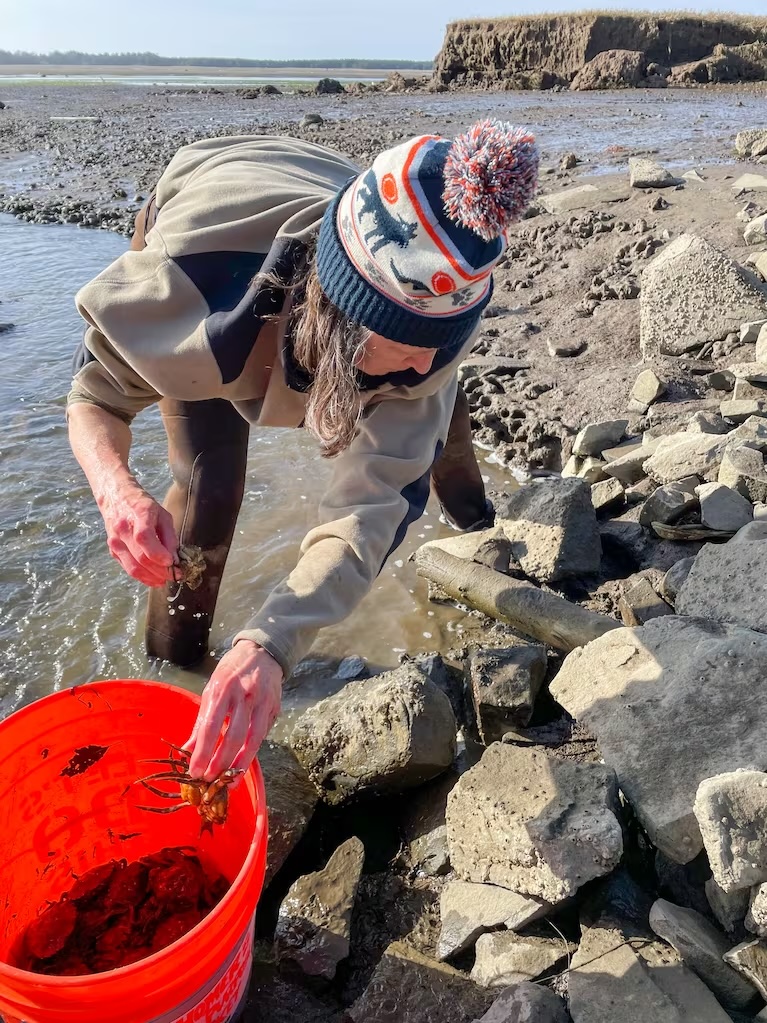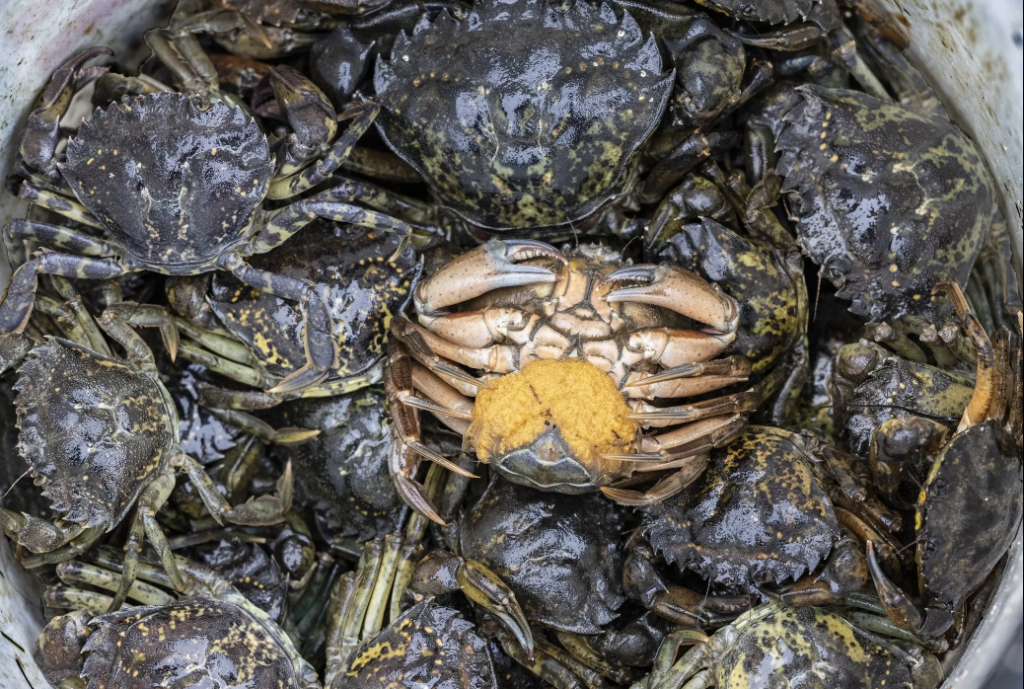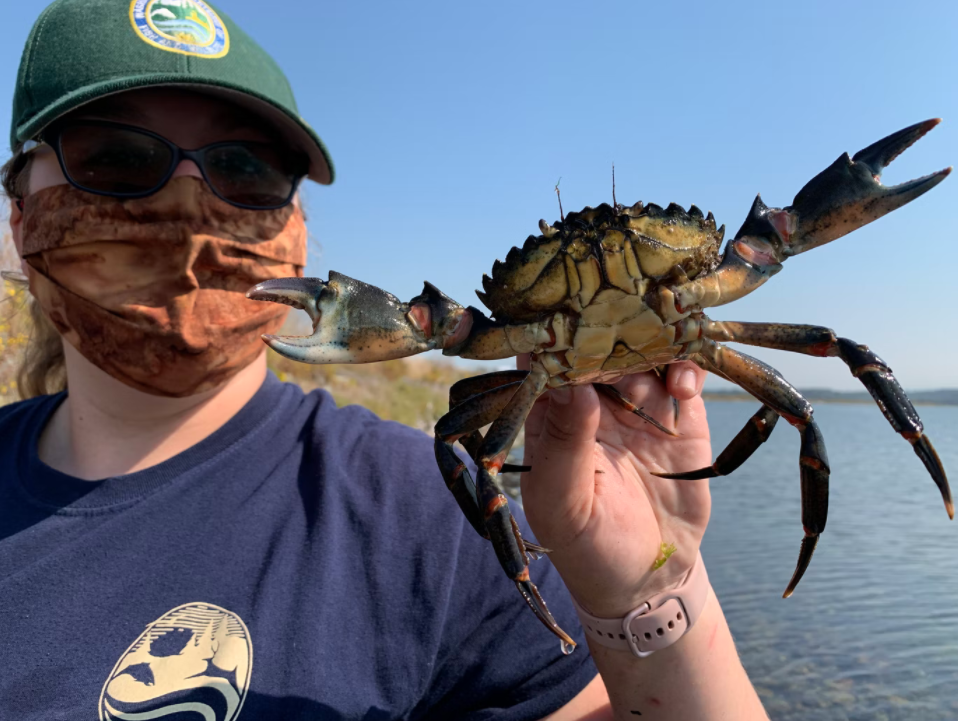
By JULE GILFILLAN/Oregon Public Broadcasting
On a summer day nearly two years ago, a team of researchers from Portland State University made their way upriver from chilly, salty Siletz Bay to the fresher, warmer waters of the Siletz River.
They were retrieving traps set earlier to see whether invasive European green crabs were finding comfy habitats in places the native Dungeness crabs find intolerable. The alien crabs outcompete Dungeness crabs for both food and habitat and pose a significant danger to that lucrative Oregon fishery.
European green crabs, as the name suggests, are native to Europe. But the hearty, tolerant crustaceans have also made themselves at home in Australia, Argentina, Japan, South Africa and on both coasts of North America.
“Green crabs have incredible tolerances for temperature. They can be much warmer than our native crabs can and thrive. But they’re also pretty successful at cold temperatures,” said Catherine de Rivera, the research team’s leader and PSU professor of environmental sciences and management.

Green crabs are also tolerant of different levels of water salinity, making them feel at home in open sea, estuaries and even up into fresh water. Their flat hind legs make them good swimmers. To top it off, European green crabs possess a set of strong claws that make it easy for them to slice into clam shells and crush the carapaces of lesser-equipped crabs.
These attributes make green crabs excellent survivors and formidable invaders, as well as a significant threat to the state’s shellfish industry.
Oregon’s Dungeness fishery brings in $80 million to $90 million a year to crabbers, and other fisheries such as oysters and bay clams are also at risk of being impacted by the invaders.
“The green crab will take whatever prey is available to them, and it’s easy pickings for them when they get into a good crop of cultivated Pacific oysters,” said Steve Rumrill, shellfish program leader for the Oregon Department of Fish and Wildlife.
Pacific oysters, which originally come from Japan, are the most widely cultivated and harvested shellfish species in the world, including here in Oregon. The presence of a voracious invader such as the green crabs makes oyster growers very nervous.
The negative impacts on oysters are not just economic. Oysters help keep bay water clean; an adult oyster can filter up to 50 gallons of water a day.
Green crabs also tear up eelgrass beds that naturally clean ocean water, absorb climate-warming carbon, produce oxygen and provide habitat for sea birds, young Dungeness crabs and other juvenile species. Loss of the grasses disrupts not just fish nurseries, but the ecosystem has a whole.
Commercial harvest of green crabs has long been prohibited in Oregon. Green crabs, while smaller than their Dungeness counterparts, are nonetheless fine to eat. Several cookbooks, in fact, have been published that contain green crab-specific recipes.
How did they get here?
Rumrill said experts think European green crabs probably came to the West Coast as fishing bait and in ballast water in the late 1980s, landing first in San Francisco Bay, then moving with ocean currents to new locations.
“They leapfrogged up the California coast into Tomales Bay and Bodega Bay and Humboldt Bay. And from there, continued that northward migration range expansion into Coos Bay,” Rumrill explained.
ODFW began monitoring European green crabs in 1996. Their presence was first noticed in Coos Bay in 1997. Within three or four years, green crabs had colonized all the bays in Oregon and the outer coast of Washington, Rumrill said.
In 2006, “Oregon Field Guide” met up with de Rivera who was working with Oregon State University researcher Sylvia Yamada to document the nascent invasion of green crabs on the Oregon coast. The team found green crabs in several of their traps but suspected the absence of an explosion in population was due to the presence of local native predators.
“Back in 2006, red rock crabs, which is a native crab we have, will prey on them, and they could keep their numbers in check. So we were keeping our eye on them, but we weren’t as worried for Oregon shellfish as we are now,” said de Rivera.
Last winter, de Rivera was able to find 263 green crabs along the rocky edges of Netarts Bay in about an hour.
“There’s no way we would have seen anything like that in 2006,” said de Rivera.
The green crab invasion was in its early stages in 2006. Since that time, ocean temperatures have warmed, making the environment favorable for green crabs, Rumrill said.
“In 2013, 2014, 2015, the populations have become well established and the numbers of individuals have doubled, quadrupled,” he said. “So, we’re into what we call the second phase of this widespread West Coast invasion.”
As climate change causes ocean temperatures to grow uncomfortably warm for our native cold-loving species, he said, it’s likely the more tolerant nonnative species will come to dominate local ecosystems.

There goes the neighborhood
While Oregon is being impacted by the presence of the green crabs, it’s Washington state that’s really feeling the creature’s painful pinch.
To combat the infestation there, last year the Washington Department of Fish and Wildlife instituted emergency measures to protect the state’s lucrative shellfish industry. The program includes year-round trapping and reported snaring in the neighborhood of a quarter-million green crabs in the last year.
While Oregon’s shellfish industry is orders of magnitude smaller than that of Washington, ODFW has not declared open season on green crabs. In Oregon, there is a harvest limit of 35 crabs, per person, per day, regardless of species. De Rivera thinks there should be no bag limit on green crabs.
“Once people can identify green crabs, then we can remove them and everyone doing their part, removing some green crabs could keep the numbers down,” reasoned de Rivera.
It’s that identification piece that has Oregon’s marine agencies concerned.
“The well-intended person who may go out and try to catch three or 400 green crab, there would likely be unintended bycatch of 30, 40, 50, 60 native crab, and we don’t want that to happen,” said Rumrill. “So, until that time that we are very confident in people’s ability to recognize the native versus nonnative species, we’re comfortable with holding that limit at 35.”

Know your crab

One area where both researchers and agency folks agree is the importance of educating the public about how to identify this pernicious invader. The first thing to know is that green crabs aren’t necessarily green.
There’s a lot of color variation in the European green crab – they can be orange, green or “very orange and red,” said ODFW’s Summer Henricksen. “So, using color, it’s impossible to correctly identify them.”
But there is a sure-fire way of telling a native Dungeness from an invasive green crab.
“European green crab have three bumps in between their eyes, and then they have five spines on either side of their eye. Dungeness crab have 10 spines. And it doesn’t change with age or color, so it doesn’t lead to the same misidentification concerns,” said Henricksen.

‘Here to stay’
While researchers like de Rivera watch the clock tick, the time and bureaucratic process involved in formulating a green crab management strategy churns on — a plan Rumrill characterizes as “conceptual planning and early development.”
Rumrill, de Rivera and other partners are developing a framework for devising a management plan for the green crab in Oregon.
“This plan is a prerequisite for Oregon to receive federal funds from the U.S. Aquatic Nuisance Species Task Force,” said Rumrill.
The state management plan will identify specific goals and objectives for monitoring and possibly control of the species in Oregon. ODFW wants to continue gathering more data before moving forward with a labor-intensive and costly trapping program, like the one currently underway in Washington.
The department is also looking to identify roles and responsibilities with other agencies such as the Invasive Species Council, Oregon Department of Parks and Recreation, Oregon Department of Agriculture and others, as well as universities and commercial shellfish growers.
It will be a long process. In the meantime, researchers like de Rivera look for whatever silver lining they can find.
“(Green crabs) have been on the East Coast for about 200 years and they’re still there,” said de Rivera, noting that other species native to the East Coast seem to be existing along with the invasive species.
“We haven’t seen extinctions because of them,” she said. “But green crabs are blamed for the crash of the soft-shell clam industry in Maine in the 1950s. And so, they have been shown to impact fisheries.”
In their summer 2022 survey, de Rivera’s team found very few green crabs upriver from Siletz Bay, which might have given them reason for optimism. But just up the coast at the mouth of the Salmon River, they found a thriving population they had not documented before.
While ODFW staff and their partners work through the bureaucracy, Rumrill acknowledges that the time for eradicating invasive green crabs from Oregon shores has passed.
“They are here to stay,” he said.
- This story originally appeared on Oregon Public Broadcasting.



Please go get the little suckers,doesn’t seem too difficult to differentiate them , the oyster fishery ,as well as the Dungeness crab populations and others seem to be in big jeopardy, beachgoers and divers should be trained to identify and fishing licenses being issued based on a simple 2minute test to show you qualified,and yes I know it’s another hoop to jump through so what ,the price you pay to play, if not go home and cry in your imitation crab soup. as a seasoned California scuba diver,certified at the age of 14 ,someone needs to stand for the environment in general, and don’t be crabby about it.!!
You are right, Chip. Why not pay folks per crab, then they can weed through some at check points. It’s sad and too bad the green ones grow as fast as algae in a pond. Oregon needs to hurry a plan. Washington did.
Well, they’re edible, why not let people catch as many green crabs as they want period in no time? It should solve the problem, What with all the tourists we get here. The solution, catch and eat.
I don’t understand why, with all the technology at hand and the programmers, they can’t create a simple online test for potential crabbers to take to show they understand which is which, then they could be approved to catch them.
Are they edible?
Years ago back in the early 80’s I moved from Chicago out to Oregon for a great job,I lived outside of Portland in Milwaukee, and loved it,in my complex a gentleman named Don befriend me and his family lived in Netarts Bay and he took me clamming and eating clam fritters 45 minutes out of the ocean was the best food I’ve ever eaten, so I said All of that to say this “get those greenies out of there.Long live Netarts Bay!!!
There shouldn’t be a permit required to catch invasive species. Educate individuals and then make it open season on them. Problem would solve itself.
Seems like the three west coast states should be working on this together, not each trying to control the crabs their own way. Seems like Oregon is, characteristically, out of the loop, as it usually is. Everyone is suffering from lack of cooperation.
Catching these invasive crabs won’t even make a dent in their population. It’s like stepping on a few hundred ants and thinking you are somehow destroying the ant population. It’s a shame. But we now have to live with it, just as we now live with the billions upon billions of invasive slugs and snails in Oregon and starlings and pests that were not here 200 years ago. Evolution and nature just wasn’t designed to deal with the massive world wide movement of goods via ships and airplanes. I guess it’s fine to try to trap them but it’s also futile.
Reading the article I immediately thought why
didn’t it show pictures comparing the eye/spine identifers between Green, Dungeness, & Red crabs. Educate Now!
Excellent idea.
Thought the same thing myself, a missed opportunity. As so readily pointed out, easy to distinguish the differnce. The governments view that folks can’t figure it out, so keep the limit to 35? How about using common sense, educate. And let the cooking begin!!
Ok so we need a license or not to catch these green crabs? I would like to start catching them. Edible and my chickens like the shells.
I’m pretty sure the green crabs are too prolific to really make a dent in them. I wnd soft shell clamming at necnicum, and I saw like hundreds of 1/2 inch onse, but there were probably thousands burrowed in the mud. This was a very small area. It would be nice to be able to start harvesting them though as thyre pretty easy to identify with 30 seconds of training.